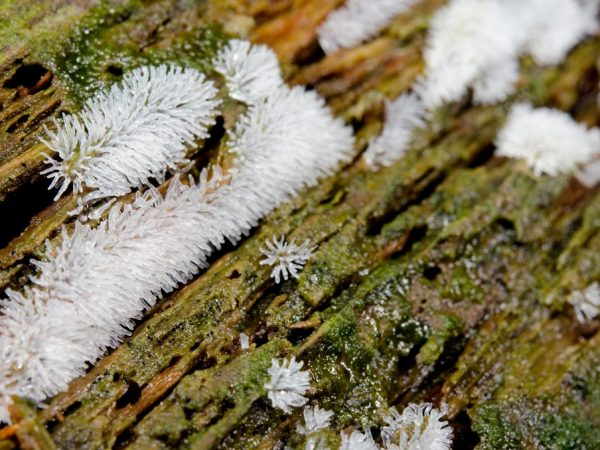Description of the Slime mold
In nature, there is a relative of fungi that can move on the surface. This organism is called "slime mold" and is allocated in a separate group. Also because of its peculiarities it is called "mixomycete", it is not edible.

Description of the slime mold
Slime mold description
This relative of fungi always looks like a slimy mass, a large amoeba. It reaches 10 cm in circumference. That is why it is also called plasmodium - it consists of one cell without a dense shell, which gives a certain shape and many nuclei.
Irina Selyutina (Biologist):
In some slime molds, plasmodia are microscopically small, in others they are rather large in size. The vegetative body, reaching a size of several tens of centimeters, usually consists of a large number of separate plasmodia, which can "scatter" in different directions and then gather together in a new place. This form is called "pseudoplasmodium" in contrast to the unicellular true plasmodium.
Such a mucus organism lives in the forest:
- under fallen leaves;
- inside rotten stumps;
- on rotten plant residues.
The slime mold moves at a speed of about 0.1-0.4 mm / min. It feeds on the remains of fallen leaves and other plants.
If the humidity is too low where the plasmodium crawls, then it stops and becomes covered with a hard shell. This is required to retain the moisture present in the cage.
It moves along the surface, smoothly fingering with "legs", which have high plasticity. Sometimes it hides its "legs" and spreads over the surface to collect moisture and sunlight. The locomotion organelles, which we call "legs" for simplicity, are not, in fact, such, since they do not have a corresponding structure. It is more correct to call them "pseudopods", since they represent the bulge of the outer flexible layer of the cytoplasm, filled with the internal cytoplasm - endoplasm.
Positive phototaxis - movement towards the light is manifested in slime molds at a certain point in their life, when they are ready to reproduce.
Irina Selyutina (Biologist):
- Plasmodium contains about 75% water, and the rest 30% proteins. In addition, it contains glycogen and pulsating vacuoles.
- Some species are characterized by the presence of a large amount of lime (up to 28%) or other inclusions.
- Most slime molds in the plasmodium have pigments that give them a variety of colors. And although the color is specific to the species, its intensity varies depending on the conditions of existence.
- Plasmodium actively moves in the direction of food sources, i.e. possesses a positive trophotaxis. It moves towards more humid places and towards the flow of water (positive hydro- and rheotaxis).
- The bulk of slime molds are saprophytic forms that live mainly in forests.
- When unfavorable conditions occur, plasmodium can turn into sclerotium - a thickened mass hardening in air.
Slime mold refers to those organisms that are susceptible to the external environment.Small fluctuations in temperature can kill them.
It does not tolerate high humidity: it swells, stops moving and slowly dies. It is saved from death only by direct sunlight, which will slowly evaporate all excess moisture from the mushroom.
It is assumed that the ability to move arose in the process of evolution, as an adaptation to the search for a new habitat and food.
Systematic groups
Slime molds, or mixomycetes for the morphological analysis of spore-bearing structures, are divided into several classes:
- Myxomycetes (mixomycetes, or real slime molds);
- Dictyosteliomycetes (dictyosteliomycetes);
- Protosteliomycetes (protosteliomycetes)
These groups differ in structure, appearance and lifestyle. Only slime molds from the Myxomycetes class can actively move.
Each of these species has special properties, but even wild animals do not use them for their food.
Beneficial features

Slime molds are used for genetic research
The properties of this relative of mushrooms are not fully understood; it is not used either as a food product or as a supplier of useful compounds for the production of medicinal products in medicine. However, they are important as model organisms for numerous biological studies.
The harm of slime mold
A number of representatives of the department are parasites of plants, causative agents of diseases of many crops, for example, causing the keel of cabbage and other cruciferous Plasmodiophora brassicae. The roots of a diseased plant are swollen and their total mass can be about half of the total mass of the plant. If the roots are cut at an early stage of infection, then mixameba or slime mold plasmodia can be seen in their cells. Another representative of the group, also of practical importance, is the causative agent of powdered potato scab - spongospore - Spongospora solani, which affects potato tubers, less often stolons, tomatoes, and other species of nightshade.
Growing methods
Plasmodium is a fungal-related organism that cannot be grown on its own. he needs a certain habitat. In order for this representative of one of the kingdoms of living nature to exist safely in a certain place, the following conditions are needed:
- certain air humidity;
- precipitation (substrate moisture);
- temperature;
- a place for growth and development.
In greenhouse conditions, the slime mold cannot grow and immediately dies. Special equipment is required. For a long time, a large number of slime molds have been cultivated in laboratory conditions on nutrient media. Approximately 40 species already in the 1970s carried out the entire cycle of their development in laboratory conditions. Therefore, they are valuable for research of various kinds: biochemical, biophysical, physiological, cytological, genetic.
Conclusion
A walking slime mold is not, in principle, edible. You will not be able to grow this representative of living nature on your own, because it is possible to create optimal conditions for it only in laboratory conditions.



